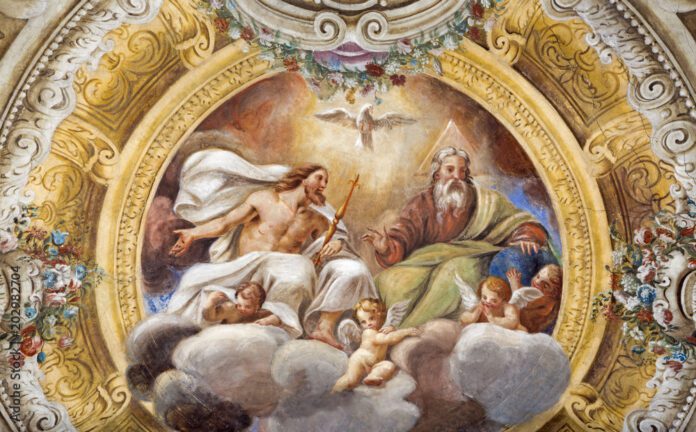If you were to pick up one of the gospels and try to read it with fresh eyes—as if you were reading it for the first time—you would be struck not only by what Jesus does, but equally by what He doesn’t do. Jesus, of course, does amazing things: He heals lepers, raises the dead to life, walks on water, and turns water into wine. But despite His obvious power, Jesus rarely uses this power at a distance. A notable exception is when the Roman centurion comes to Jesus and asks Him to heal his servant. Jesus offers to come and heal him, but the centurion gives his famous reply, “Lord, I am not worthy to have you come under my roof, but only say the word, and my servant will be healed” (Mt. 8:8). The centurion puts his trust in Jesus’ power to save, even at a distance, and Jesus rewards him for his faith: “Go; let it be done for you as you have believed” (Mt. 8:13).
Of the over twenty healing stories in the gospels, on only three occasions does Jesus use His power at a distance (Mt. 8, Mt. 15, Jn. 4). And even then, this is only because someone comes to Jesus and asks Him to do so. Jesus doesn’t go around healing people willy-nilly, without having some personal encounter either with the person who is sick, or with someone who loves and cares for them. This reveals to us that Jesus didn’t come primarily to perform miracles, but to bring people to faith in Him. The miracles often elicited an act of faith, or were done as a response to an act of faith, but the miracles weren’t the point; they were secondary. The point was to have a personal encounter with Jesus and be brought into a saving relationship with Him. This happened best when Jesus met the person in a fully human way: through the sound of His words, the sight of His face, and the touch of His hand.
God the Father, in His infinite power, could have saved us at a distance. From the comfort, so to speak, of heaven He could have spoken the word and we would have been restored to right relationship with Him. But this is not what someone who loves does, and we know this to be true from experience. A mother who gives birth prematurely, doesn’t want her child to remain a minute longer in the NICU. She is not content to see or talk to her child through the glass walls of the incubator; she wants to hold her child in her arms.
A father waits at the airport to greet his son who is returning from military service overseas. The video calls these past months haven’t been enough. He wants to see his son in person, shake his hand, and give him a big hug. Mothers and fathers are not content to love at a distance; their love compels them to cross that distance, so that they can love their children in a fully human way. If this is true of human parents, how much more of our Triune God in whose image parents are created?
This Sunday we are celebrating the Solemnity of the Most Holy Trinity. The risk this Sunday is to get caught up in trying to explain the mystery of the Trinity without any reference to how this great mystery was revealed to us in salvation history. God the Father revealed this mystery to us by sending His Son, which we celebrated at Christmas and Easter. The mystery was further revealed to us at Pentecost, when the Father and the Son together sent the Holy Spirit. That is why we can finally celebrate Trinity Sunday: because the fullness of the mystery has been revealed. All the gifts have been unwrapped, and it’s time to celebrate all we’ve been given.
Our readings this weekend reveal to us the motive behind these two missions of the Son and the Holy Spirit. In our first reading, God commands Moses to go up Mount Sinai with two blank stone tablets. Moses had destroyed the first two tablets when he came down the mountain and saw the people worshiping the golden calf. As a punishment for this grave sin of idolatry, God told Moses to take the people and leave Mount Sinai. He would send an angel with them as they journeyed to the Promised Land, but He Himself would not go with them (Ex. 33:1-3). Moses pleaded with the Lord, reminding Him that it was precisely His presence among them that made them distinct from all the other people on the face of the earth (Ex. 33:16). We hear Moses reiterating this plea with the Lord at the end of our first reading: “If I find favor with you, O Lord, do come along in our company. This is indeed a stiff-necked people; yet pardon our wickedness and sins, and receive us as your own” (Ex. 34:9). Because the Lord loves His people, because He is “a merciful and gracious God, slow to anger and rich in kindness and fidelity” (Ex. 34:6), He goes with them on their journey, not depriving them of His presence.
God’s desire to be with His people which is prefigured in our first reading is brought to fulfillment in the New Testament. It says in our first reading that the Lord “stood” with Moses. It also says that the Lord came down upon the mountain in a cloud. We see something remarkably similar in the Transfiguration: Peter, James, and John see Jesus standing on the mountain with Moses (and Elijah). They also see a cloud, and a voice coming from it. Despite our stubbornness, despite our wickedness and sins, God still wants to be with us. He loves us, and He wants to be with us in a fully human way. And so He sends His Son: “God so loved the world that he gave his only Son” (Jn. 3:16). Then, order that might still be able to encounter Jesus through His Church, even after Jesus ascended into heaven, the Father and the Son sent the Holy Spirit.
God is love. And He is not content to love us at a distance. In both the Old and New Testaments, it’s clear that God wants to be with His people. And He wants to be with us so that we can encounter Him in a fully human way and enter into a saving relationship with Him. This is the Triune God whom we celebrate this weekend. And if we are made in the image of that Triune God, then it follows that how God loves us is the measure of how we ought to love one another.
This has a lot of practical implications for us today. If God calls us to love our neighbor, then He calls us to love our neighbor in a fully human way: not at a distance, but up close and personal. If God calls us to love the poor, He wants us to share a meal with a poor person. If God calls us to love our enemy, He wants to sit down and have a civil conversation with them. Before the advent of radio, television, and now the internet, the only way to encounter someone was in person. Because we encounter more people now on a daily basis through digital mediums than we do in person, we have been trained to treat people first and foremost as digital objects rather than as personal subjects. This has to change if we want to love our neighbor as God loves us. Our goal as Christians should be to maximize personal encounters with people. That way, when we do encounter people through digital mediums, we will remember that they are subjects with God-given dignity, rather than objects for us to use as we please.
And so you see, the Mystery of the Trinity, which may seem terribly abstract to us, is actually incredibly practical and concrete. Our Triune God is revealed to us as a God who loves, not at a distance, but up close and personal. He wants to see us, to hear our voice, and to reach out His hand to us in tenderness and compassion. To truly believe in this Triune God in whose image we are created is to seek to do the same. Amen.






